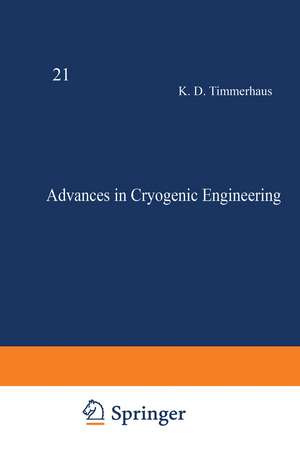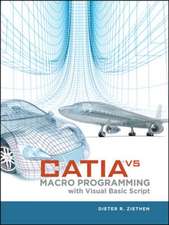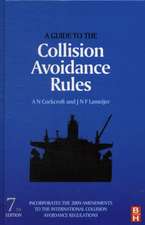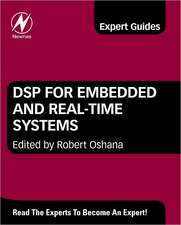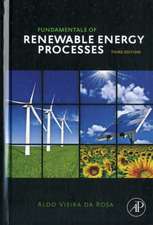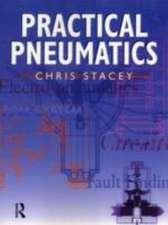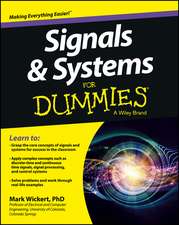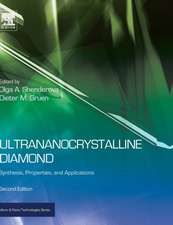Advances in Cryogenic Engineering: Advances in Cryogenic Engineering, cartea 21
Editat de K. Timmerhausen Limba Engleză Paperback – 26 noi 2012
| Toate formatele și edițiile | Preț | Express |
|---|---|---|
| Paperback (4) | 410.28 lei 43-57 zile | |
| Springer Us – 10 oct 2013 | 410.28 lei 43-57 zile | |
| Springer Us – 12 oct 2012 | 412.02 lei 43-57 zile | |
| Springer Us – 15 noi 2011 | 421.43 lei 43-57 zile | |
| Springer Us – 26 noi 2012 | 660.37 lei 43-57 zile |
Din seria Advances in Cryogenic Engineering
- 18%
 Preț: 1848.16 lei
Preț: 1848.16 lei - 15%
 Preț: 649.87 lei
Preț: 649.87 lei -
 Preț: 406.25 lei
Preț: 406.25 lei -
 Preț: 410.46 lei
Preț: 410.46 lei -
 Preț: 433.19 lei
Preț: 433.19 lei -
 Preț: 444.13 lei
Preț: 444.13 lei -
 Preț: 452.62 lei
Preț: 452.62 lei -
 Preț: 499.95 lei
Preț: 499.95 lei -
 Preț: 426.23 lei
Preț: 426.23 lei -
 Preț: 423.18 lei
Preț: 423.18 lei - 15%
 Preț: 618.91 lei
Preț: 618.91 lei - 18%
 Preț: 1238.86 lei
Preț: 1238.86 lei - 24%
 Preț: 1745.96 lei
Preț: 1745.96 lei - 18%
 Preț: 1841.23 lei
Preț: 1841.23 lei - 18%
 Preț: 1842.31 lei
Preț: 1842.31 lei - 18%
 Preț: 1833.33 lei
Preț: 1833.33 lei - 24%
 Preț: 1051.64 lei
Preț: 1051.64 lei
Preț: 660.37 lei
Preț vechi: 776.90 lei
-15% Nou
Puncte Express: 991
Preț estimativ în valută:
126.40€ • 137.35$ • 106.25£
126.40€ • 137.35$ • 106.25£
Carte tipărită la comandă
Livrare economică 21 aprilie-05 mai
Preluare comenzi: 021 569.72.76
Specificații
ISBN-13: 9781475702101
ISBN-10: 1475702108
Pagini: 568
Ilustrații: XVI, 550 p. 70 illus.
Dimensiuni: 178 x 254 x 30 mm
Greutate: 0.97 kg
Ediția:1975
Editura: Springer Us
Colecția Springer
Seria Advances in Cryogenic Engineering
Locul publicării:New York, NY, United States
ISBN-10: 1475702108
Pagini: 568
Ilustrații: XVI, 550 p. 70 illus.
Dimensiuni: 178 x 254 x 30 mm
Greutate: 0.97 kg
Ediția:1975
Editura: Springer Us
Colecția Springer
Seria Advances in Cryogenic Engineering
Locul publicării:New York, NY, United States
Public țintă
ResearchCuprins
Superconducting Magnets.- A—1 Superconducting Magnetic Levitation and Linear Synchronous Motor Development—The Canadian Program.- A—2 Split-Pair Superconducting Magnet System for Self-Colliding Beam Experiments.- A—3 Cryogenic Design Considerations of a Superconducting Magnet System for Self-Colliding Beam Experiments.- A—4 Large Superconducting Solenoid for the Minimag Experiment.- A—5 Cryogenic and Mechanical Design of a Large, Six-Tesla Dipole Magnet.- A—6 Superconducting Toroidal Field Magnets for a Tokamak Engineering Test Reactor.- A—7 A One-Meter-Diameter, AC Superconducting Coil and Fiberglass Cryostat for an Electromagnetic Geophysical Exploration System.- Applied Superconductivity Systems Design.- B—1 Preliminary Tests of Subscale and Full-Scale Single-Phase Sections of a 3400-MVA Superconducting Transmission Line.- B—2 Cryogenic Design for Large Superconductive Energy Storage Magnets.- B—3 Engineering Considerations of the Toroidal Magnet and Dewar for UWMAK-11—A Wisconsin Tokamak Fusion Reactor Design.- B—4 Current Averaging and Coil Segmentation in the Protection of Large Toroidal Superconducting Magnet Systems.- B—5 Dielectric Strength of Liquid Helium under Strongly Inhomogeneous Field Conditions.- B—6 Electrical Breakdown and Tracking Characteristics of Pulsed High Voltages in Cryogenic Helium and Nitrogen.- B—7 Temperature Excursions During Loss of Magnet Coolant Accidents with Thermalization of Energy of Large Superconducting Solenoids.- Superconductive Energy Systems.- C—1 Applications of Superconducting Magnets to Energy with Particular Emphasis on Fusion Power.- C—2 Configurational Design of Superconductive Energy Storage Magnets.- C—3 Energy Transfer Methods Between Superconducting Magnets.- C—4 ElementRating and Coupling Harmonics in a Superconductive Energy Transfer System.- Energy Systems.- D—1 Economic Aspects of U. S. Energy Independence in the Coming Decade.- D—2 Cryogenic Fuel Systems for Motor Vehicles.- Refrigeration.- E—1 Reliability Aspects of Cryogenic Refrigeration.- E—2 A New Helium Refrigerator for Superconducting Cable Systems.- E—3 Supercritical Helium Refrigerator for Superconducting Power Transmission Cable Studies.- E—4 Low-Temperature Losses in Supercritical Helium Refrigerators.- E—5 New Type Screw Compressor for Helium Refrigerators and Liquefiers.- E—6 Dry Helium Compressor for Refrigeration Systems.- E—7 Performance Tests of a Reciprocating Liquid Helium Pump Used in Forced Convection Cooling.- E—8 A Large-Scale Pumped and Subcooled Liquid Helium Cooling System.- E—9 High-Purity Nitrogen Cooling System of an In-Core Irradiation Cryostat for a Triga Mark II Reactor.- Instrumentation.- F—1 Surface Crystalline Carbon Temperature Sensor.- F—2 Sensor for Distinguishing Liquid-Vapor Phases of Superfluid Helium.- Heat Transfer and Fluid Dynamics.- G—1 Heat Exchangers for Vapor-Cooled Conducting Supports of Cryostats.- G—2 The Cooling of Long Conduits.- G—3 Heat Transfer in a Cryosurgery Probe Tip.- G—4 Heat Transfer in Transition Boiling of Cryogenic Liquids.- G—5 Liquid Neon Heat Transfer as Applied to a 30-Tesla Cryomagnet.- G—6 Free Convection Film Boiling from a Flat, Horizontal Surface in Saturated He II.- G—7 Thermomechanical Flow Rates of Liquid Helium II Through Channels of Large Hydraulic Diameter.- G—8 Maximum Two-Phase Flow Rates of Subcooled Nitrogen Through a Sharp-Edged Orifice.- LNG Technology.- H—1 Experience of Tokyo Gas with In-Ground LNG Tanks.- H—2 Geometric Stability of Cylindrical,Double-Walled Cryogenic Tank Structures.- H—3 A Model for LNG Tank Rollover.- H—4 Distrigas LNG Barge Operating Experience.- H—5 Inert Gas Generating System for Liquefied Natural Gas Carriers.- H—6 Running-Film Vaporizer for LNG.- Safety.- J—1 Planning for Safety.- J—2 Safety Aspects of LNG Spills on Land.- J—3 Dispersion of Hydrogen or Methane Fuels Released into an Automobile Interior.- Cryo-Bioengineering Applications.- K—1 The Application of Cryogenics to the Reversible Storage of Biomaterials.- K—2 Recent Advances and Applications of Freeze-Drying Technology.- Cryo-Technology Applications.- L—1 Miniature Cryogenic Coolers.- L—2 Orbital Performance of a Solid Cryogen Cooling System for a Gamma-Ray Detector.- L—3 Nitrogen Removal and Raw Helium Recovery in Natural Gas Processing Plants.- L—4 Heavy Water Production by Cryogenic Processing.- L—5 Techniques for Obtaining Cryogenic Laser Fusion Targets by Condensing Fuel Gases in Microshell™ Pellets.- Fluid Properties.- M—1 Recent Developments in the Theory of Fluid Mixtures.- M—2 On the Consistency of Liquid-Vapor Equilibria Data for Binary Mixtures of Methane with the Light Paraffin Hydrocarbons.- M—3 Excess Enthalpies for Some Binary Liquid Mixtures of Low-Molecular-Weight Alkanes.- M—4 Viscosity of Cryogenic Liquid Mixtures (Including LNG) from Corresponding States Methods.- M—5 Solubility of Solid n-Butane and n-Pentane in Liquid Methane.- M—6 Orthobaric Liquid Densities of Normal Butane from 135 to 300 K as Determined with a Magnetic Suspension Densimeter.- M—7 Thermophysical Properties Data Research on Compressed and Liquefied Gases at the NBS Cryogenics Division.- M—8 A Method for the Selection of a Functional Form for a Thermodynamic Equation of State Using WeightedLinear Least Squares Stepwise Regression.- Indexes.- Author Index.
